A lateral root primordium1(LRP1) gene regulates fruit wart in cucumber
IF 5.7
2区 生物学
Q1 PLANT SCIENCES
引用次数: 0
Abstract
Fruit wart density critically determines cucumber marketability, yet its regulatory mechanisms remain poorly understood. In this study, EMS mutagenesis generated the high-wart mutant 'mc-mu', which was crossed with the low-wart inbred line 'CR' for genetic analysis. Through MutMap-based mapping, we identified CsaV3_5G036780 (CsLRP1) on chromosome 5 as the causal gene regulating wart density. CsLRP1 encodes a SHI/STY-family protein implicated in auxin biosynthesis. We developed a CRISPR/Cas9 editing system to investigate CsLRP1's role, generating knockout lines via Agrobacterium-mediated transformation. Phenotypic analysis revealed that CsLRP1-deficient plants exhibited significantly increased wart density and reduced basal fruit diameter compared to wild-type, without other morphological alterations. Yeast two-hybrid assays demonstrated physical interaction between CsLRP1 and CsSCZ-21. qRT-PCR analysis further indicated that CsLRP1 negatively regulates wart density, while bioinformatic analyses suggest its potential modulation of auxin signaling pathways. These findings advance our understanding of cucumber wart formation and provide practical targets for breeding programs focused on improving fruit quality traits.
黄瓜侧根原基1(LRP1)基因调控果疣
果疣的密度决定了黄瓜的适销性,但其调控机制仍然知之甚少。本研究通过EMS诱变产生高疣突变体mc-mu,并将其与低疣自交系CR杂交进行遗传分析。通过基于mutmap的定位,我们确定了5号染色体上的CsaV3_5G036780 (CsLRP1)是调节疣密度的致病基因。CsLRP1编码一个与生长素生物合成有关的SHI/ sti家族蛋白。我们开发了一个CRISPR/Cas9编辑系统来研究CsLRP1的作用,通过农杆菌介导的转化产生敲除系。表型分析显示,与野生型相比,缺乏cslrp1的植株疣密度显著增加,基果直径显著减小,但没有其他形态改变。酵母双杂交实验证实CsLRP1和CsSCZ-21之间存在物理互作。qRT-PCR分析进一步表明CsLRP1负调控疣体密度,而生物信息学分析表明CsLRP1可能调控生长素信号通路。这些发现促进了我们对黄瓜疣形成的理解,并为提高果实品质性状的育种计划提供了实用的目标。
本文章由计算机程序翻译,如有差异,请以英文原文为准。
求助全文
约1分钟内获得全文
求助全文
来源期刊
CiteScore
11.10
自引率
3.10%
发文量
410
审稿时长
33 days
期刊介绍:
Plant Physiology and Biochemistry publishes original theoretical, experimental and technical contributions in the various fields of plant physiology (biochemistry, physiology, structure, genetics, plant-microbe interactions, etc.) at diverse levels of integration (molecular, subcellular, cellular, organ, whole plant, environmental). Opinions expressed in the journal are the sole responsibility of the authors and publication does not imply the editors'' agreement.
Manuscripts describing molecular-genetic and/or gene expression data that are not integrated with biochemical analysis and/or actual measurements of plant physiological processes are not suitable for PPB. Also "Omics" studies (transcriptomics, proteomics, metabolomics, etc.) reporting descriptive analysis without an element of functional validation assays, will not be considered. Similarly, applied agronomic or phytochemical studies that generate no new, fundamental insights in plant physiological and/or biochemical processes are not suitable for publication in PPB.
Plant Physiology and Biochemistry publishes several types of articles: Reviews, Papers and Short Papers. Articles for Reviews are either invited by the editor or proposed by the authors for the editor''s prior agreement. Reviews should not exceed 40 typewritten pages and Short Papers no more than approximately 8 typewritten pages. The fundamental character of Plant Physiology and Biochemistry remains that of a journal for original results.

 求助内容:
求助内容: 应助结果提醒方式:
应助结果提醒方式:


